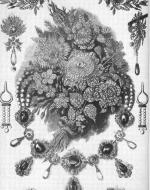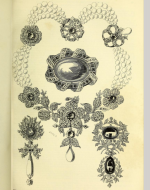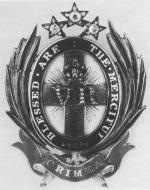Created by Julia Schempp on Mon, 02/17/2025 - 20:03
Description:
During the Victorian era, jewelry was not only a fashion statement, but a form of expression that reflected wealth, social status, and personal sentiments, such as love, loss, and close relationships. Many of these pieces were created with symbols that held deep sentimental value, often inspired by different aspects of nature, such as flowers or animals. Symbolism played a very big role in Victorian society, as it was very commonly seen in art and literature, as well as used to convey discreet messages. For example, many authors used symbols from nature to convey deeper meanings and evoke certain emotions within their readers. Jewelry also showed one's social status, as it was very expensive, so only the upper class had the opportunities to wear it.
My Booth. For my booth, I tried to replicate a jewelry display you would see in the Great Exhibition of 1851, using vintage jewelry I got from Professor Golden. I also pasted a background on cardboard and a Victorian woman on top of that to model one of the necklaces I include in my exhibition. I chose one of my favorite pieces from my exhibition for this, which I pasted onto the woman to look like she was wearing it. Aside from this, I pinned some fabric to the bottom part of the cardboard, which is what I attatched the jewelry to. I chose to use fabric because I could pin the jewelry to it easily, and also because it had a very Victorian feel to it.
Plate 24. Group of jewellery Selected from the Costly and Elegant Assortment Exhibited by Messrs. Hunt and Roskell. Jewellery in the Great Exhibition from the 1851 Illustrated London News, The Victorian Web. This image shows a group of assorted jewelry pieces by Hunt and Roskell that was on display in the Great Exhibition of 1851. The exhibit included some of the gems from Henry Hope's famous collection, including green and pink diamonds, sapphires, rubies, emeralds, and a Hungarian opal that was more than an inch long. This display is also very floral, with the center of attention being on the big sunflower in the middle. In floriography, sunflowers are bright flowers that represent adoration or loyalty. Based on this, it can be assumed that this jewelry display was made to evoke similar feelings.
Plate 215. Jewelry, Opals, and Brilliants. Messrs. Hunt and Roskell, The Official Descriptive Catalogue of the Great Exhibition of the Works of Industry of all Nations, 1851. This is an image of a piece that was displayed in the Great Exhibition, taken from the Great Exhibition Catalogue, created by Hunt and Roskell. This is another floral piece with the main focus being on the big jewel in the middle. The charms on the necklace are held together by pearls, which are a symbol for wealth and status. There also seems to be a lot of leaves/vines in this display, which could represent growth or unity.
Plate 126. The 'Florence Nightingale' Brooch designed by Prince Albert and made by Messrs. Garrard. 1855. Courtesy of the National Army Museum,The Victorian Web. This is an image of a brooch which was given to Florence Nightingale by the Queen in 1855. She sent it along with a letter, which commemorated her for her work. Nightingale was not as grateful as the Queen thought she would be, but she did still wear it. I think that this shows how one's wealth was able to influence their life during this time. Nightingale recieved a most likely very expensive gift from the Queen herself, yet was not grateful.
"Coral Bracelet with the head of Bacchus and bacchantes. 1860–69," The Victorian Web. This is an image of a gold and highly prized red coral bracelet. The head of Bacchus--the Roman God of wine, agriculture, and fertility--is engraved in the coral. This was a very creative choice, as coral was worn by Roman women as a fertility charm. This is only one example of the many kinds of symbolism that was portrayed Victorian jewelry.






